Drought Conditions Have Retreated Across Puerto Rico and the U.S. Virgin Islands.
Drought conditions have retreated over the past two months across Puerto Rico and the Virgin Islands. All climatic regions of the island have experienced significantly higher than normal rainfall since the last report in August. The U.S. Virgin Islands are also out of drought, and no longer even abnormally dry (D0). After November, the normal climatology of Puerto Rico and the U.S. Virgin Islands is generally dry.
View this update in Spanish.
Key Points
- Puerto Rico Conditions: During the past two months, due to heavy tropical rains, all drought has been removed from Puerto Rico. For example, San Juan has seen 20.48 inches of rain since September 1. This is the 4th wettest such period on record, dating back to 1899.
- U.S. Virgin Islands Conditions: No drought conditions are currently observed over the U.S. Virgin Islands. The two main reporting stations in St. Croix and St. Thomas are now above normal in observed rainfall year to date.
- Puerto Rico Impacts: A surplus of rainfall across the island has improved conditions in areas previously affected by drought. and there are no reported drought impacts.
- U.S. Virgin Islands Impacts: All major islands in the USVI are receiving heavy intermittent rain. Farmers are still preparing for the upcoming dry season.
- Looking Ahead: The climatology of Puerto Rico indicates that during the next two months (December–January), conditions will be drier. For example, the monthly average rainfall at Cyril King Airport in St. Thomas drops from 6 inches in November to only 5.5 inches combined in December and January.
- For weather information specific to your area, please monitor products issued by the National Weather Service in San Juan, Puerto Rico.
The latest weekly U.S. Drought Monitor map for Puerto Rico. The U.S. Drought Monitor is updated each Thursday to show the location and intensity of drought across the country. As of November 1, no drought conditions are observed in Puerto Rico.
The latest weekly U.S. Drought Monitor assessment for the U.S. Virgin Islands. The U.S. Drought Monitor is updated each Thursday to show the location and intensity of drought across the country. As of November 1, no drought conditions are observed in the Virgin Islands.
U.S. Drought Monitor Categories
The latest weekly U.S. Drought Monitor map for Puerto Rico. The U.S. Drought Monitor is updated each Thursday to show the location and intensity of drought across the country. As of November 1, no drought conditions are observed in Puerto Rico.
The latest weekly U.S. Drought Monitor assessment for the U.S. Virgin Islands. The U.S. Drought Monitor is updated each Thursday to show the location and intensity of drought across the country. As of November 1, no drought conditions are observed in the Virgin Islands.
Drought Conditions
- Puerto Rico: No drought conditions are observed.
- U.S. Virgin Islands: No drought conditions are observed.
Sector Impacts
General Conditions
- Puerto Rico: A surplus of rainfall across the island has improved conditions in areas previously affected by drought. However, excess rainfall has caused negative impacts such as flooding, impassable roadways, saturated soils, and landslides in some regions.
- U.S. Virgin Islands: All islands in the USVI have received above-normal rainfall since early September, which has helped remove previous drought conditions. Ponds are recharging, and collection containers are filling up. Horse ranchers and livestock farmers are continuing to conserve water, rotate livestock, and prepare and plan for the upcoming dry season due to the recent USVI long-term drought. Farmers indicated that water prices increased this year, so conservation methods and increased livestock forage, along with continued water resource planning, are needed to address long-term conditions.
Agricultural Conditions
- Puerto Rico: Excessive and continuous rainfall in some regions of Puerto Rico has created challenging conditions for farmers. Post-hurricane Fiona clean-up and recovery efforts have been hampered by reported flooding, blocked or closed roadways, and saturated soils. Reports out of Cabo Rojo, Lajas, Hormigueros, and Toa Alta detail flooded and impassible roadways.
- St. Thomas: Intermittent rain is recharging ponds, and farmers are reporting that water levels are above what they have encountered over the past two years. Poultry farmers indicated that due to sporadic rain, they are still conserving and are purchasing additional containers to hold water for the dry season to allow for the watering of chickens. Poultry producers also stated increased rain is slightly impacting egg production. Farmers are reporting windy weather, which is impacting fruit trees. In St. Thomas, agriculture and private ponds have filled. Sporadic rain is slowly recharging them, and farmers indicate that water use from these ponds will be monitored. Specialty and row crop farmers are reporting that vegetation is bouncing back. Orchards, which require more water, are still being planted, and farmers are hoping the trees will bear fruit in the coming season. Most are taking seriously the drought conditions from the past two years and are now employing conservation methods, including the increased storage capacity of water. Many are also working to deploy detailed conservation plans to deal with long-term drought conditions.
- St. John: Farmers are reporting that they are still working on conserving water despite recent rain. Vegetation, including fruit trees, is bouncing back due to much-needed precipitation. Sporadic heavy rain is allowing growers to make the most of the water resources available and implement conservation plans such as increasing collection for the drier months ahead.
- St. Croix: Farmers are concerned about trees that were downed due to heavy winds from the previous storms that have recently hit the island. Farmers are reporting increased costs related to the costs of replanting trees. They also indicated that the overall costs of water and feed due to severe drought over the past two years have them worried about the summer months ahead. The VI Department of Agriculture (VIDA) also reported that St. Croix water deliveries to the agricultural community in September were 856,150 gallons. In October, water deliveries were reported by VIDA as 1,230,710 gallons. The number of gallons listed in September was reduced due to a downed well and pump along with intermittent power outages, which impacted overall access to water services on STX. VIDA is consistently working with local and federal partners to address infrastructure needs to support water access which impacts water needs for community garden use and the increased request for delivery services to farms across the islands during times of drought.
Photo Gallery of Conditions
Puerto Rico
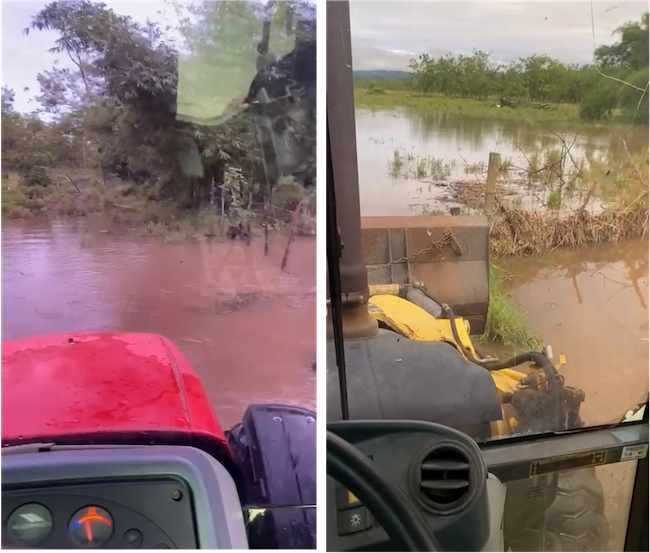

U.S. Virgin Islands
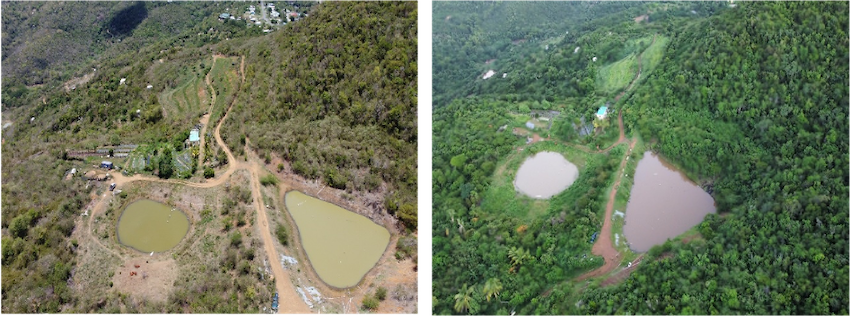

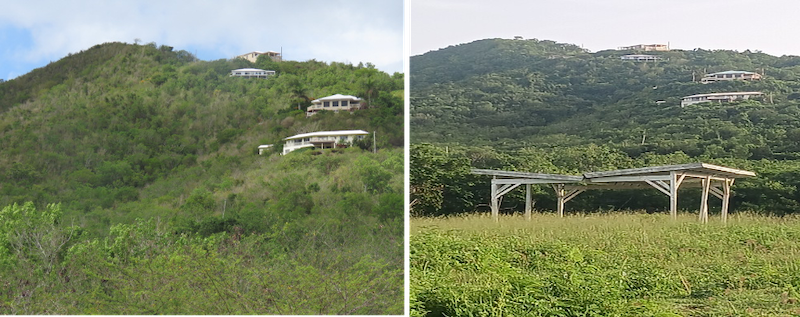
Rainfall Trends
- Puerto Rico: Higher than normal rainfall (compared to 1980–2010 Climate Normals) has been observed across all climate zones in the Island since the previous report on August 18. The surplus precipitation ranges from about 23% in the north coast to 96% in the southern slopes (Figure 1).
- U.S. Virgin Islands: All reporting stations in the USVI noted between 14 inches and 17 inches of rainfall in September and October. This is about 140% to 170% of normal.
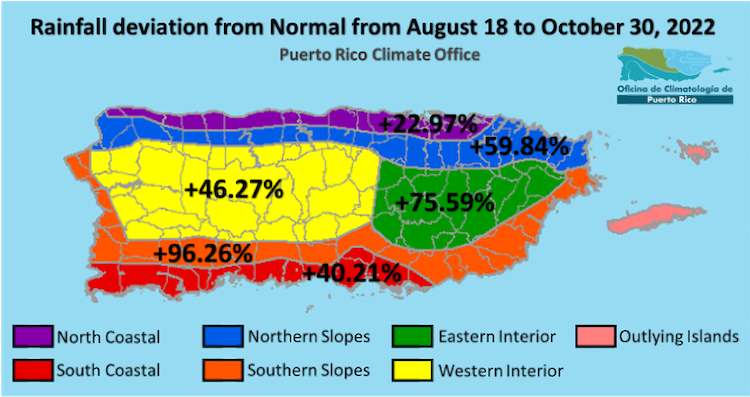
Soil Moisture Conditions in Puerto Rico
The latest soil moisture data from the Puerto Rico Agricultural Water Management (PRAGWATER) indicates drastically improved soil conditions across most of Puerto Rico, compared to the previous report in September (Figures 2 and 3). A small area of fairly dry soil remains in the north coast in and around Arecibo.
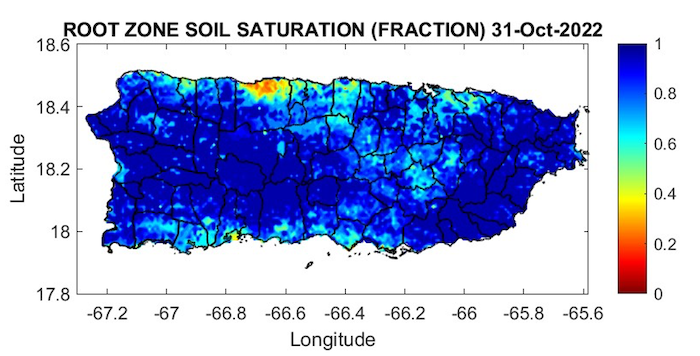
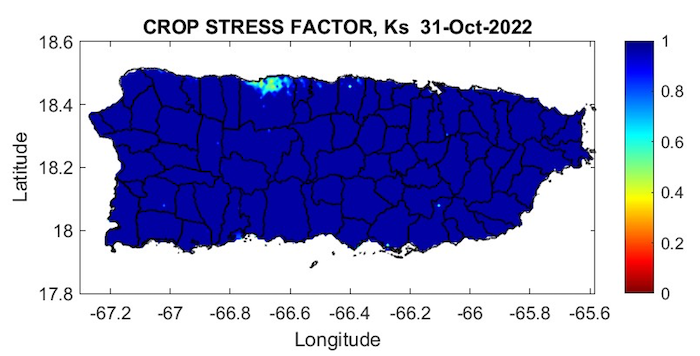
Streamflow and Reservoir Conditions in Puerto Rico
The 7-day average streamflow from the U.S. Geological Survey (USGS) river gauge network (Figure 4) indicates that all streamflows across the island are at or above normal.
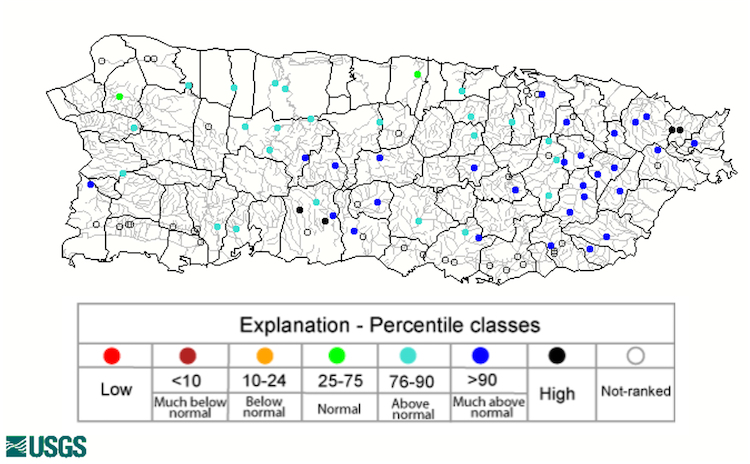
Groundwater Conditions
A few well levels remain below normal in south-central and north-coastal Puerto Rico. Across all the U.S. Virgin Islands, groundwater levels are near normal (Figure 5).
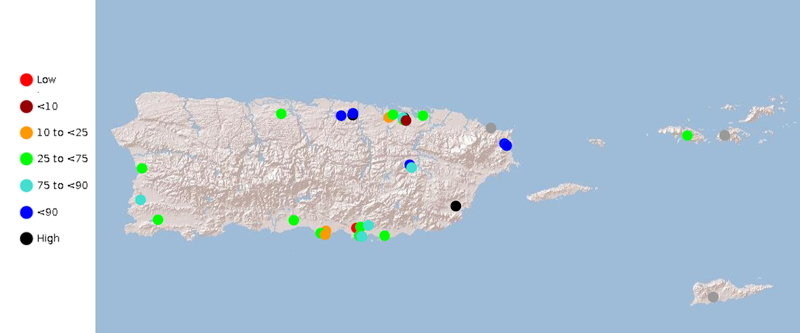
Outlooks and Impacts
Rainfall Outlook
The climatology of Puerto Rico indicates that during the next three months (November–January) we should see a transition to the dry season. The IRI multi-model probability forecast for precipitation (Figure 6A) indicates that the region is most likely to have equal chances for above-, below-, or near-normal rainfall, whereas the 3-month extended forecast by the Caribbean Climate Outlook Forum (CariCOF) indicates increased chances for a slightly wetter than normal period (Figure 6B).
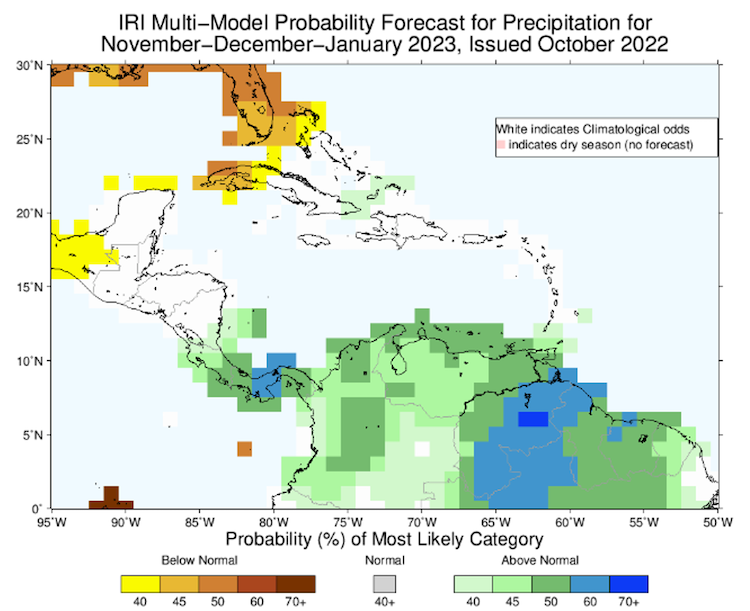
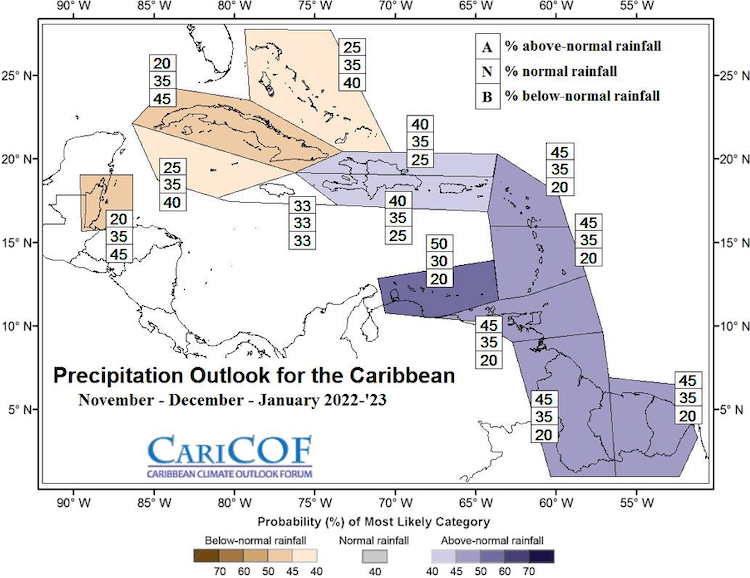
For More Information
- National Weather Service (NWS) Weather Forecast Office – San Juan: Climate and Drought Information
- NWS Drought Information Statements for Puerto Rico and the U.S. Caribbean
- Drought.gov:
- Caribbean Drought Bulletins. Caribbean Regional Climate Center, Caribbean Institute for Meteorology and Hydrology (CIMH), Barbados
- U.S. Department of Agriculture (USDA) Caribbean Climate Hub drought and disaster assistance resources for tropical forestry and agriculture
Prepared By
Héctor J. Jiménez
Office of Climatology, University of Puerto Rico
Odalys Martinez
Senior Service Hydrologist, NWS Weather Forecast Office – San Juan
Meredith Muth
NOAA/National Integrated Drought Information System (NIDIS)
Victor Murphy
National Weather Service Southern Region
Christina Chanes, Gregory Guannel
University of Virgin Islands
William Gould, Nora Álvarez-Berríos, Eva Holupchinski
USDA Caribbean Climate Hub, USFS International Institute of Tropical Forestry
Brad Rippey
USDA Office of the Chief Economist
Puerto Rico Reporting Input: Thanks to the Agricultural Extension Service, College of Agricultural Sciences, University of Puerto Rico-Mayaguez. Special thanks to Eric Harmsen, Professor of Agricultural Engineering UPR-M; Harry Ramirez and Isela Ortiz, Southwest Soil and Water Conservation District Inc. (DCSAS), Agro. Alberto J Maldonado Rodríguez and Ian Pagán Roig, Agroecological Project el Josco Bravo.
USVI Reporting Input: Several individuals contributed to this report, and we are acknowledging the following for their support, including the faculty, staff and collaborators of the UVI Physics Program, UVI Etelman Observatory, UVI Agricultural Experiment Station, VI Department of Agriculture, as well as the USDA Office Chief Economist, National Parks Service in St. Croix, USDA Farm Service Agency, Coral Bay Community Council and the many field staff, volunteers, drought reporters and farmers from across the territory.
About This Report
This drought update is issued in partnership between the National Integrated Drought Information System (NIDIS), National Oceanic and Atmospheric Administration (NOAA) National Weather Service, the U.S. Department of Agriculture (USDA), and the University of the Virgin Islands. The purpose of the update is to communicate a potential area of concern for drought expansion and/or development within Puerto Rico and the U.S. Virgin Islands based on recent conditions and the upcoming three-month forecast.
NIDIS and its partners will issue these updates every two months. Subscribe for these U.S. Caribbean drought updates here.







